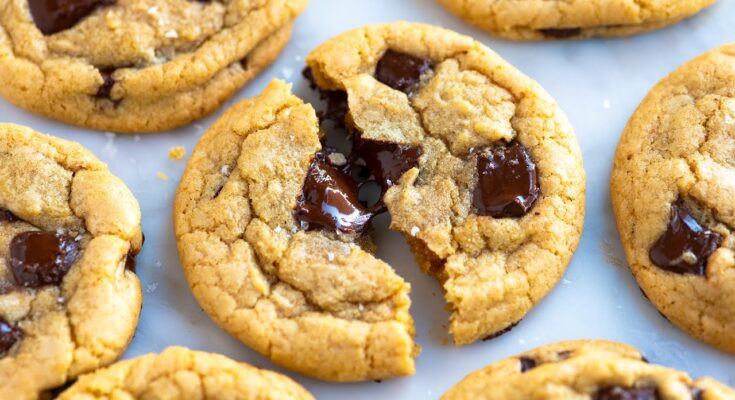Cookies Recipe: Who doesn’t love the comforting aroma of freshly baked cookies wafting through the kitchen? Cookies are one of the most beloved treats around the globe, perfect for any occasion—or no occasion at all!
Whether you prefer classic chocolate chip cookies or crave something more adventurous, baking cookies at home is a rewarding experience. Plus, when you bake your cookies, you get to control the ingredients and customize them to your heart’s desire.
Let’s dive into this foolproof, step-by-step guide to baking the perfect batch of cookies.
Ingredients for Making Perfect Cookies
Basic Ingredients
The foundation of any cookie recipe lies in its ingredients. For a classic cookie, you’ll need:
- Flour: The base that gives your cookies structure.
- Sugar: Both white and brown sugars for sweetness and chewiness.
- Butter: Adds richness and flavor.
- Eggs: Binds the dough and adds moisture.
- Baking Powder or Baking Soda: Helps the cookies rise slightly and stay soft.
- Vanilla Extract: Enhances the flavor.
Optional Add-ins
Want to jazz up your cookies? Try:
- Chocolate Chips: A classic choice for gooey goodness.
- Nuts: Add crunch and flavor depth.
- Dried Fruits: Raisins or cranberries add a chewy twist.
- Flavor Extracts: Almond, coconut, or peppermint can elevate your cookies.
Essential Tools
To ensure smooth baking, gather:
- Measuring Cups and Spoons: For precise ingredient measurements.
- Mixing Bowls: Separate bowls for wet and dry ingredients.
- Baking Trays: Non-stick or lined with parchment paper.
- Spatula and Whisk: For thorough mixing.
Preparing to Bake
Preheating the Oven
Preheat your oven to 350°F (175°C). This step is crucial because placing dough into an unheated oven can result in uneven baking. Set your oven timer and let it heat while you prepare the dough.
Setting Up the Workspace
Organize your kitchen space before starting. Lay out all your ingredients and tools. Trust us; having everything at arm’s reach makes the process smoother.
Importance of Exact Measurements
Baking is a science, and accuracy is key. For instance, too much flour can make your cookies dry, while too little sugar affects their texture. Always level off your measuring cups for precision.
Mixing the Dough
Creaming Butter and Sugar
Start by creaming softened butter and sugar together until the mixture is fluffy and light. This step incorporates air into the dough, ensuring soft, tender cookies.
Adding Wet Ingredients
Beat in the eggs one at a time, followed by vanilla extract. These ingredients help bind everything together and add moisture.
Combining Dry Ingredients
In a separate bowl, whisk together flour, baking powder (or soda), and a pinch of salt. Gradually add this mixture to the wet ingredients, stirring just until combined. Overmixing at this stage can lead to tough cookies.
Shaping the Cookies
Choosing Cookie Shapes
Decide on the shape of your cookies. You can opt for classic round cookies or use cookie cutters for fun shapes, especially during holidays.
Using a Cookie Scoop or Hands
A cookie scoop ensures consistent sizes, but clean hands work just as well. Roll the dough into small balls for even baking.
Spacing on the Tray
Place your cookies about 2 inches apart on the baking tray to prevent them from merging into one giant cookie.
Baking the Cookies
Setting the Right Temperature
Double-check your oven temperature before placing the tray inside. Bake your cookies for 10–12 minutes or until the edges are golden brown.
Checking for Doneness
Don’t wait for cookies to look completely done in the oven. They continue to cook on the tray as they cool. Remove them when they’re lightly browned at the edges and soft in the center.
Cooling the Cookies
Transfer your cookies to a wire rack after a few minutes to prevent overbaking. Let them cool completely before decorating or storing.
Adding the Finishing Touches
Decorating Cookies
Now comes the fun part—decorating your freshly baked cookies! You can use icing, sprinkles, or melted chocolate to make them visually appealing. For a simple decoration, drizzle some melted white or dark chocolate over the cookies and let it harden. If you’re feeling adventurous, pipe colorful designs with royal icing or top with edible glitter for a festive touch.
Adding Fillings
If you want to elevate your cookies further, consider adding fillings. Spread a layer of frosting, Nutella, or peanut butter between two cookies to create sandwich cookies. Alternatively, try stuffing the dough before baking with caramel or chocolate chunks for a gooey surprise inside.
Storing Leftover Cookies
To keep your cookies fresh and delicious, store them in an airtight container at room temperature for up to a week. For longer storage, freeze them. Place a sheet of parchment paper between each cookie to prevent sticking, and thaw them at room temperature when you’re ready to enjoy them.
Tips for Customizing Your Cookies
Adjusting Sweetness
Not everyone has the same sweet tooth, and that’s okay! If you prefer less sweetness, reduce the amount of sugar slightly. For those who like their cookies extra sweet, add a drizzle of honey or sprinkle coarse sugar on top before baking.
Flavor Variations
Experimenting with flavors can lead to delightful surprises. Add a pinch of cinnamon, nutmeg, or cardamom to your dough for a warm, spiced flavor. You can also mix in orange or lemon zest for a zesty twist that pairs beautifully with chocolate or nuts.
Making Gluten-Free Cookies
If you or someone you know has a gluten intolerance, don’t worry—you can still enjoy cookies! Substitute regular flour with almond flour, coconut flour, or a gluten-free baking mix. Just make sure to adjust the liquid ratios in the recipe, as these flours absorb moisture differently.
Common Mistakes to Avoid
Overmixing the Dough
It’s tempting to keep stirring until the dough looks smooth, but overmixing can lead to dense, tough cookies. Stop as soon as the ingredients are combined, especially after adding the flour.
Incorrect Oven Temperatures
An improperly calibrated oven can ruin your cookies. If your cookies often burn or come out uneven, invest in an oven thermometer to ensure the temperature is accurate.
Neglecting Cooling Time
Skipping the cooling step might result in cookies that fall apart or lose their texture. Patience is key—give them a few minutes to cool on the tray, then transfer them to a wire rack to cool completely.
Serving Ideas for Cookies
Pairing with Beverages
Cookies and milk are a timeless duo, but don’t stop there! Pair chocolate chip cookies with coffee, oatmeal cookies with tea, or spiced cookies with a warm mug of hot cocoa.
Creating a Dessert Platter
Cookies can be the star of a dessert platter. Arrange them alongside brownies, cupcakes, and fresh fruit for a visually stunning and delicious spread.
Packing as Gifts
Homemade cookies make excellent gifts. Use decorative tins, boxes, or cellophane bags tied with ribbons. Include a handwritten note with the recipe for a personal touch.
FAQs about Cookies Recipe
1. What are the basic ingredients needed for a cookies recipe?
Most cookie recipes require a few fundamental ingredients: flour, sugar (either white, brown, or a combination), butter or oil, eggs, and a leavening agent such as baking soda or baking powder. You can add flavorings like vanilla extract, chocolate chips, nuts, or dried fruits to enhance your cookies.
2. How long does it take to bake cookies?
The baking time for cookies typically ranges from 8 to 15 minutes, depending on their size and thickness. It’s crucial to check your cookies at the lower end of the baking time to prevent over-baking, as they continue to cook slightly once removed from the oven.
3. Can I make cookies without eggs?
Yes, you can make cookies without eggs. Suitable substitutes include applesauce, mashed bananas, yogurt, or commercial egg replacers. These alternatives help to bind the ingredients together, much like eggs do.
4. How do I make my cookies chewy or crispy?
For chewy cookies, use more brown sugar and bake them just until they are set. For crispy cookies, increase the amount of white sugar and butter and bake them a few minutes longer than usual.
5. Why do my cookies spread too much while baking?
Cookies spread due to several reasons like too much sugar or butter, overly softened butter, or a warm baking sheet. To prevent excessive spreading, ensure your butter is at room temperature (not melted), measure your ingredients accurately, and chill the dough before baking.
6. Can I freeze cookie dough?
Absolutely! Cookie dough freezes well for up to 3 months. Roll your dough into balls and freeze them on a baking sheet before transferring to a freezer-safe bag. You can bake them directly from the freezer, adding a few extra minutes to the baking time.
Conclusion
Baking cookies is more than just creating a sweet treat; it’s an experience filled with creativity, love, and the joy of sharing. By following this step-by-step guide, you can master the art of cookie baking and customize recipes to suit your taste. So, preheat that oven, gather your ingredients, and get ready to bake the most delicious cookies ever. The best part? You can enjoy the fruits of your labor and share them with loved ones. Happy baking!



